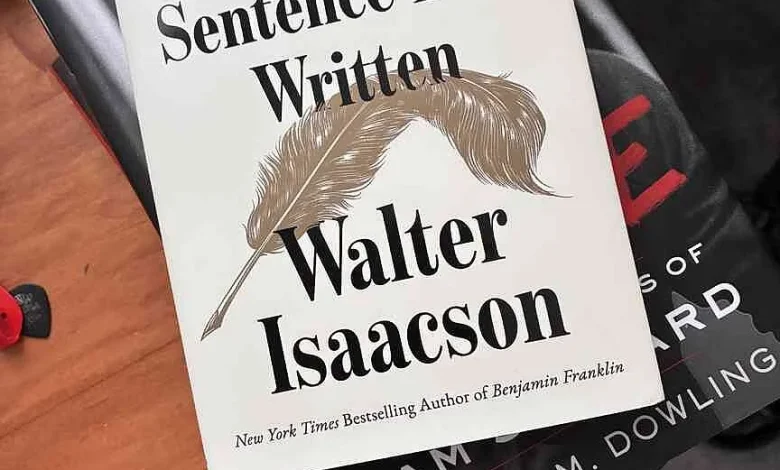OPINION | PHILIP MARTIN: Walter Isaacson on the Declaration of Independence and the 26 Words That Defined America

Let us read it for you. Listen now.
Your browser does not support the audio element.
Author Walter Isaacson is drawn to minds that bend the world. He writes about men who catch lightning, who bottle reason, who turn math into light and light into money. He likes people whose thoughts leave a visible trail.
In “Benjamin Franklin: An American Life,” he traces curiosity as a civic virtue; in “Einstein: His Life And Universe,” he finds grace in the equations of space and time; in “Steve Jobs” and “Elon Musk” he watches invention turn inward toward personality. Each book begins with the same quiet premise: Genius, at its best, is a way of turning thought into something that lasts.
This time Isaacson swivels his attention from invention to intention. His new book isn’t about a man. It’s about a sentence–80 pages on 26 words that have changed everything once and might do it again. It arrives ahead of the Declaration of Independence’s 250th birthday–a reminder that the nation is about to celebrate a document that still feels unfinished, a promise still under construction.
We hold these truths to be self-evident, that all men are created equal …
It’s a line you know before you read it, the way you know a hymn from the first moaning organ chord. Isaacson calls it “the greatest sentence ever written,” and he may be right. He listens to it the way a musician listens to a familiar tune, hearing where the notes ring and where they’ve gone flat. “We hold,” he notes, is an act of faith. “Self-evident,” Franklin’s edit of Jefferson’s “sacred and undeniable,” is an act of reason. Each word moves the idea a little farther down the road, and those inches make all the difference.
Isaacson doesn’t hide the cracks. Jefferson could write that all men are created equal while owning other human beings. The man who gave us the purest line about freedom couldn’t imagine its full meaning. Isaacson faces that plainly. The flaw isn’t an exception to the story; it’s the story itself–a promise written by someone who couldn’t yet keep it. The wonder is that the promise outgrew the man who made it. The sentence became better than its author, and it’s been teaching us how to read it ever since.
The book moves slowly, deliberately, like a conversation. Isaacson writes not to argue but to notice. He follows the sentence through time, from Jefferson’s desk to Lincoln’s speeches, from the steps of the Lincoln Memorial to the marchers in Selma, watching how each generation tries to make the words mean more than they did before.
Lincoln heard them as prophecy, a seed waiting to germinate. Frederick Douglass heard them as indictment, proof that the nation had fallen short of its rhetoric. Elizabeth Cady Stanton heard them as invitation and wrote “and women” into the line. Martin Luther King Jr. heard them as a promissory note, a moral debt still unpaid. Every listener added something to the sound. The meaning of the sentence has never been still; it keeps modulating as the country keeps changing key.
In Isaacson’s telling, the line is less scripture than song, open to variation, dependent on performance. Each generation plays it differently. Lincoln’s interpretation lifted it out of 1776 and planted it in 1863. When he said the nation was “conceived in liberty and dedicated to the proposition that all men are created equal,” he was quoting the Declaration almost word for word, but changing its tense. Jefferson’s was a statement of revolt; Lincoln’s a statement of renewal. Equality became not a birthright but a goal. That subtle shift turned rebellion into refounding.
Douglass’ reading was angrier but carried the same strange faith. When he asked, “What, to the American slave, is your Fourth of July?” he was holding the sentence up like a mirror and asking the country to look. His fury was not against the words but on their behalf. The power of the Declaration was that it could accuse the nation that wrote it.
A century later, King used the same words as a guarantee. His “promissory note” metaphor–that America had written a check on the bank of justice and allowed it to bounce–recast the sentence as a binding contract. You could measure the nation’s progress by how far its practice lagged behind its poetry. That’s the moral voltage the line still carries: It lets us keep indicting ourselves without giving up on the possibility of redemption.
Isaacson is less interested in proving a thesis than in recovering an attention span. He wants to remind us that democracy began as an act of reading, that our political experiment started with a few men trying to get the words right. The Declaration was a draft, not a revelation. The founders argued over every syllable. Franklin’s quiet substitution turned divine truth into human reason, and in doing so, gave ordinary minds the authority to see justice for themselves. It was a small change with a long echo: a shift from believing to thinking, from being told to noticing. That edit built a nation that could be revised.
The sentence has been under revision ever since. Danielle Allen, in “Our Declaration: A Reading of the Declaration of Independence in Defense of Equality,” treated it as a shared poem of citizenship. Garry Wills, in “Inventing America: Jefferson’s Declaration of Independence,” heard it as a work of Scottish moral philosophy disguised as politics. Pauline Maier, in “American Scripture,” found that it was not unique–that colonies and townships across the continent were already writing in that same declarative rhythm, as if freedom were a chorus waiting for a melody.
Isaacson joins them as a craftsman listening for tone. He treats the sentence as an artifact of design, an engine of thought built to endure friction. A good sentence, he says, is engineered; so is a country. Both survive through repair. Every amendment, every protest, every argument in the streets is a kind of edit–another attempt to align our lives with our language.
Reading his book in this moment feels like taking a deep breath. The word “truth” grows unstable. Facts are negotiable, meanings melt in real time, and shared vocabulary frays at the edges. Isaacson doesn’t offer a cure, only a reminder: When the ground shakes, go back to the words. Test their weight. See what still holds. The Declaration is not a relic of certainty; it’s a manual for self-correction. It insists we can start again, that language can be a form of repair.
Every July 4, there is a motley parade of citizens in Little Rock’s Hillcrest neighborhood that ends up on the corner of Colonial Court and Crystal Court, across the street from the playground of Pulaski Heights Middle School. Young parents pull festooned wagons piled with children; dogs wear flags. Then Brent Walker, who has done it for years, stands on the curb and gives a dramatic reading of the Declaration.
These past few years the ritual has felt especially poignant. The words sound older, maybe wiser, certainly sadder. Yet when Walker reaches that famous sentence, the crowd still murmurs it along with him, as if repeating the spell might make it hold. That neighborhood reading–sun-dazed, sincere–is its own kind of faith. The sentence endures because we keep saying it aloud.
There’s something almost tender in the way Isaacson writes about Jefferson and Franklin and Adams. He doesn’t carve them into monuments. He lets them breathe as men at work, leaning over a draft, arguing about commas, listening for cadence. You can feel their hope that a sentence might do what armies could not: define a people by the rhythm of a thought. That faith in language, more than any creed, is the American religion: The belief that words, if built well, can hold our contradictions long enough for us to grow into them.
It’s easy to forget that the Declaration wasn’t meant to last forever. It was a temporary document, written to justify a rebellion. Yet the words outlive the cause. They become the conscience of the country that was still being imagined. Each time the nation has broken faith–in slavery, in segregation, in exclusion and indifference–someone goes back to the sentence and said, “Look. It’s right here.” The line is used to wound and heal, to justify and resist, but endures because it demands to be tested.
Isaacson writes about people who believe ideas could be built–Franklin’s experiments, Einstein’s equations, Jobs’ devices, Musk’s rockets. Now he’s writing about the first American prototype: the idea of equality itself. He seems to understand that a country is a piece of unfinished engineering, that the Declaration was a first draft we still haven’t completed. What began as Jefferson’s argument has become a national apprenticeship in revision.
That apprenticeship continues in ways both large and ordinary. Every time a court wrestles with the meaning of equal protection, every time a teacher reads the Declaration aloud to a restless classroom, every time a citizen walks into a polling place or a protest and insists that the words apply to them too, the sentence breathes again. It’s printed on paper, vulnerable, renewable, asking to be reread. Isaacson’s book is a reminder that the survival of democracy depends less on policy than on literacy, on our willingness to keep reading and rereading the words that made us possible.
The danger now is not that we will reject the sentence, but that we will stop hearing it. We’ve turned it into a recitation, a ritual of memory rather than meaning. Isaacson asks us to slow down, to notice how the clauses lean on one another, how the rhythm carries the thought. The words are meant to be spoken aloud. They are built for breath. When he reads the sentence, he hears not the solemnity of a creed but the patience of a draft–a line that expects to be rewritten.
When you finish the book, you feel steadied. Not inspired, but reminded that our noise and anger are happening inside a larger story, guided by a line written in ink that hasn’t yet faded. “We hold these truths.” The plural matters. The holding matters. Truth isn’t a possession; it’s a practice. The work is in the holding–in refusing to let go of the idea, even when it disappoints us, especially when it does.
Isaacson ends where he began, with the sentence itself. He doesn’t tell us what to do with it. He trusts the words to outlast our confusion. After revolutions, civil wars, depressions and reckonings they remain. The sentence waits for us, calm and exacting, as if to ask one more time whether we still mean it. Maybe that’s the point of reading it again–not to celebrate, not to condemn, but to remember that a single line can still hold a country together, long enough to give us another chance to get it right.
Because in the end, Isaacson’s subject isn’t Jefferson or Franklin or the sentence itself. It’s the fragile miracle of meaning, the belief that words can survive their authors, that ideas can outgrow their contradictions, that a nation can keep revising itself toward the truth it claimed to see. His book, like the sentence it studies, doesn’t conclude; it endures. It waits, the way democracy always waits, for someone to read it again and decide to believe it once more.





